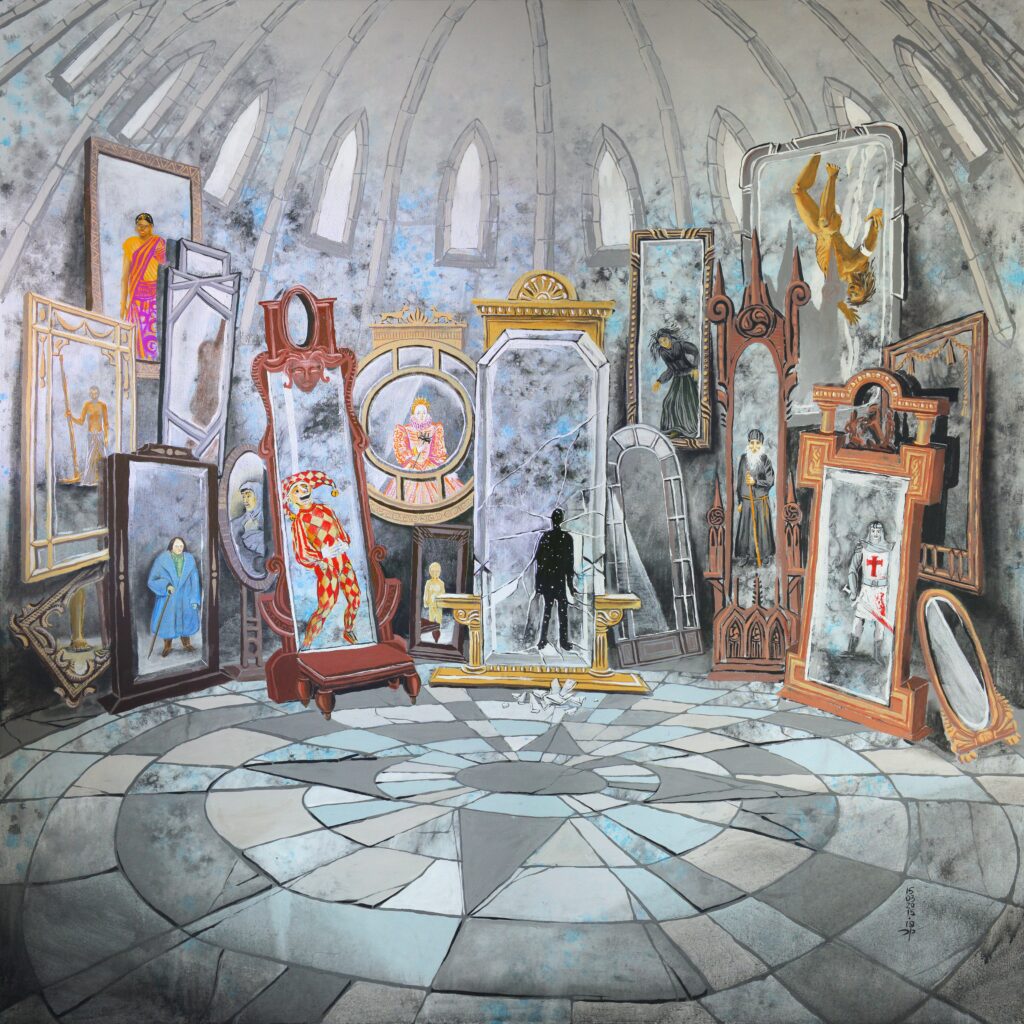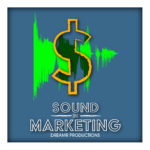I interviewed Steve Keller, Sonic Strategy Director for Studio Resonate at Pandora for the Sound in Marketing Podcast (Episode 29 and 30) about his coined phrase “Audio Alchemy”. Steve has a truly unique voice in the sound environment and I was so excited to get just a snapshot of what he brings to the industry.
‘Studio Resonate is an audio-first consultancy that ‘makes stuff.’
At Studio Resonate, Steve blends art and science creating sonic strategies and content for companies and agencies all over the world. With a degree in psychology and over 30 years of experience in the music and advertising industries, his work explores the ways music and sound impact consumer perception and behavior.”
Over the past 15 years, Steve has been an early proponent in the field of sonic branding. There have been many more conversations and new explorations in the sound space. However, in the area of marketing, old routines and habits can be pretty hard to compete with.
Smart speakers, wearables, and hearables have created limitless means of faceless engagement and experience opportunities. Brands are now marketing themselves in purely auditory spaces. So how does a brand stand out on a “digital shelf without a visual input”? The issue has been realized, but our bad habits of diving in from a tactical perspective continue to distract us. Steve encourages brands to step back from the tactical and explore a more broad and strategic approach.
Strategic Rather Than Tactical Approach
“No one is arguing the power of sound,” Steve says. “They are simply undervaluing it as an asset. Although we’re trying to be sensitive and consistent to the sensory touch points, we are much less disciplined and intentional; it’s very much an afterthought.”
Sonic identity doesn’t start with your ears; it starts with what’s between them.
Steve Keller
Exploring and understanding sound science is Steve Keller’s approach. This allows the brand to understand the impact sound has on our perception and behavior and how we can use this to “stack the deck.” Using this knowledge and ingenuity, we can align brand intent with consumer perception.
Audio Alchemy
Audio Alchemy, as Steve refers to it, is the blending of sound science with sound art. If we are successful with a blend as such in our brand, then we’ve created somewhat of a magical experience.
With traditional marketing, we tend to focus on one side of the spectrum or the other. On one hand, we may create a full blown artsy experience relying heavily (or solely) on the artistic expression of the music or the visual. On the other hand, we may approach it from the numbers perspective where decisions are based solely on demographics locations and interests.
We should be creating as many touch point references to what we think the customer will enjoy rather than focusing only on the customer as numbers.
With understanding the science of sound, we will realize that there is a huge value and potential in . But just like with an overtly artsy approach, we don’t want to “over science”.
Steve Keller
Low Functioning Vs. High Functioning Sonic Identity
If you pair any stimulus with a response, it is a conditioned behavior. Compare them with a brand as many ways as possible and you’re very likely to get the recall that you’d like. This is the case with a jingle or a single mnemonic (short sound melody or phrase).
- Read more about jingles and sonic logos here.
On the more long term side of things, fusing the sonic DNA of that stimulus into other parts of the brands ecosystem gets something far more intentional and long lasting in design. Exploration of how that stimulus is a working participant of the brand and the brand experience can now be done. The brand can stimulate certain behaviors by the consumer purposely.
With this knowledge, creation can begin representing every consumer touchpoint where there’s an audio component. This results in the consumer recognizing a true feeling and emotion for the brand going beyond just a repetitive 5 note phrase that they’ve been conditioned to recall.
High functioning sonic identity has the capacity to draw in the emotional connection needed to create the highly desired financial return.
Steve Keller
The “It” Value
Martin Lindstrom wrote a book called Brand Sense: Sensory Stuff Behind the Stuff We Buy. One example that he cites is how Singapore Airlines has a distinct smell within their airplane cabin. To better understand the aroma, travelers have asked to elaborate on the smell. Although most passengers said they couldn’t describe it, they agreed they would recognize it once they were to smell it again. It’s familiar to them. The airline did a great job at creating a higher functioning sensory experience through smell.
Sound Doesn’t Happen in a Vacuum
Sound works within all of our senses. In the realm of psychophysics, we’ve discovered that we base reality on sensory input.
We can’t separate the importance or significance of sound from the other senses as they all play a part together.
Steve Keller
For example, you can match certain sounds with scent or colors or even taste. Matching scent with sight is possible. So how do we match a sound congruently with another sense? I believe that that answer is different for each individual brand and company. It is possible to attribute all senses within a brand to draw in the consumer. However, this takes work and strategy. Attribution and connection is not a tactical response.
If you’re congruent they will come.
Steve Keller
We’re tapping into something ancient. This idea of cross modelism happens all over in languages. We cross high and low frequencies over languages and somehow we understand each other.
For example, we hear a piece of music and we think, “that sounds sweet”. We’ve now described the music with a flavor adjective. If we can harness this idea of what “sweet” sounds like, we’ve stepped into a whole new level of emotional connection and interpretation. We can modify the experience in order to create an actual “taste”…through a sound.
Propel Water and Sound
Propel Vitamin Water was looking for a unique activation around their brand that involved sound. Pandora and Resonate Sound decided to look at the flavor components of the brand. The two flavors that came into play were the fruit taste and the electrolytes. A huge component to electrolytes is sodium which has a flavor all its own..salty.
Propel and Pandora set out to play with cross modalism to impact the flavor of Propel with soundscapes that were designed to bring out the flavor of the fruit (sweet) and the flavor of the electrolytes (salt).
Steve brought in a researcher colleague, Janince Wang, from the Department of Food Science at Aarhus University. The first experiment was through a food survey trying to tease out the “sonic seasonings” (pitch, frequency, white noise, tempo, rhythm, etc). They asked themselves the question ‘what do people naturally associate with “saltiness”’.
From that, they created a sonic landscape that was then tested in a lab. The outcome was a soundtrack that, through the research, they found they could emphasize the perception of sweetness or emphasize the perception of the saltiness. They created an app called Flavor DJ. With a fader that the consumers could toggle back and forth between the 2 soundscapes. They found they could move the faders one way or another to experience one taste sense over the other.
The experience gave Propel a ‘conversation starter’. With this conversation starter, Propel could then talk about the electrolytes and the power of the blend, the natural phenomenon of the experience in general, and how they could apply this research in their lives in health settings.
This was an experiential piece that was sonically driven.
Sound In Healing
As I discussed in Sound Saves the Day, I talked about the healing power of music. Steve elaborated on this with his published research paper from late 2019, Medicine’s Melodies.
Music soundscapes and noise have an impact on health and wellness. Sound can affect outcomes. From a nutritional standpoint, sound can be used to get people to eat more (increasing caloric intake). Sound can also be used for diabetic patients to take certain things out of their diet through a natural way. This can have huge positive implications.
Sound and music impacts the taste buds of cancer patients while struggling through their illness. Can sound and music bring back the desire, flavor and pleasure of eating when it is crucial for them to get their proper caloric intake? Yes.
How can we use these lessons of health and well being in sound in the marketing world? How can we be more purposeful and meaningful and go beyond just “selling something”? How can we bring something of value to the world and treat it as a sonic intervention?
Steve Keller
There may be many patient benefits to sound therapy, but the healthcare industry is looking more towards experience and satisfaction. Sound can do both. This could mean a lot in terms of healthcare brand building.
Mastercard; A Multi-Sensory Experience
Raja Rajamannar, CMO of Mastercard, is connecting the dots through a multi-sensory perspective and experience. This is the heart of Mastercard’s new initiative. Since this article was released in early 2019, they have created so much more than just a sonic logo. Their sound has become the DNA of their brand. To see a behemoth of a company embrace voice technology and the power of sound is truly inspiring to me. And they don’t stop there.
Their strategy really boils down to “intentional sound”. One such example is their interest in unique experiences in their experiments. This article tells how In New York, they took over a space and partitioned it into different recreations of famous restaurants. They created a look and a feel to transport the audience into a different environment by infusing scent and sound into the experience. A wonderful social and sensory experiment that they continued on with up until January 2020.
Audio Innovation
There are currently a plethora of innovative sound opportunities that are challenging us to think differently about sound in general. There are also ways of testing and measuring those innovations through neuroscience. We can explore what are the most anecdotal concepts around sound and what are the more empirically based elements. Those results are what we can lean into more fully in the science of it all.
Experiences are drawn from the perceptual input throughout our senses in all the different environments that we move in and out of. This is what we’re “limited” to and all we have to explore, learn and improve upon.
The customer journey has sound throughout. If you’re not mapping your sonic ecosystem, you’ve got so much room for improvement.
Steve Keller
Conversational AI
Can AI tell a cohesive story throughout the brand’s ecosystem especially in areas the brand hasn’t been aware of yet? Can we train a conversational Bot to speak a sincere brand story? These are all questions we are currently seeking the answers to.
Some of the ways that Steve and I discussed that companies are succeeding at this could be through playing into a bias, or speaking in a way that is more relevant to the part of the country that the consumer lives in; a certain ethnicity. However, this runs into problems as well.
If by playing into your bias’ a brand can trigger a recall, what’s the potential for that when we start thinking about sonic propaganda?
Steve Keller
As discussed in Ep. 12 of the Sound In Marketing Podcast, it is a wild west of audio ethics right now. At some point, people will realize that there is regulation that needs to be done but not right now. At present, morals are determined very much individually. Look at Facebook. This was all new territory for the courts and regulators. And now here we are.
As Steve states, we’re trying to influence perception and behavior through both the marketing and the creative industries. This is done to try and relay an impactful message. Or at least that is the goal.
The transformative power of art is in our lives. Advertisers and brands have a responsibility to use this power… responsibly.
Steve Keller
Sound As A Savior
In Ep. 27/28 of the Sound in Marketing Podcast, I talked with Rachel Lowenstein and Arafel Buzan about how we’ve been overstimulated by the visual. The idea of going back to sound as the primary, gives us a rest from the “noise” of the visual.
The visual ‘noise’ that exists in our environment can be exhausting. Taking a reprieve out of chaos is always good from time to time. On the other hand, it is just as easy to be overstimulated by sound.
How are we solving the problems of overstimulation in sonic “noise” as we are facing in the visual space?
Archetypes
Archetypes was not a word that I was familiar with before my conversation with Steve. And so just in case you aren’t either, I’ll summate. Carl Jung, a swiss psychiatrist and psychoanalyst, looked at stories and mythologies all across the world in different parts of history. He discovered that there were recurring themes and characters that existed independently of the different cultures. Jung called these archetypes. Different “personas” one can attribute themselves to.
Brands often talk about themselves in terms of archetypes. There’s the jester archetype, the hero, the innocent, the caregiver, the lover. They’ll look at their brand purpose and meaning from an archetype standpoint and perspective.
Steve suggests, “could we do the same thing with sound?”
Sound is used to engage memories and heighten experiences. To think that you can get your brand point across sonically not just “you need to see the benefits of the product” brings you into a whole new realm of opportunity.
For example, we’ve been told “this” is what beauty “looks like”. What if you don’t look like that? Can you truly relate to that brand if you feel you don’t meet its expectations? However, if we were to tell the story through sound, we’re told the story through our own mind and imagining the image for ourselves. Then “beauty” is defined by us.
We don’t talk about how sound can communicate meaning as well as emotion and mood. We feel it.
Steve Keller
Research On Audio Archetypes
Steve did some research with Daniel Müllensiefen and Christian Wong at Goldsmith’s University in London on how audio archetypes could play into things. Can we truly personify through audio archetypes? What they found was that composers could encode semiotic information into music that could then be decoded by the user or listener. We can communicate these archetypes through sound. This impacts how we’re interpreting the world.
We can change a visual narrative by changing the sonic narrative. Now we can talk about emotion in the context of an archetype.
Steve Keller
Wrapping Up
Steve Keller and many others are on the forefront of discovering not only that communication through sound and music is possible and can help shape the narrative, but also how to make this form of communication a common practice. As sound in marketing progresses, I predict we’ll be hearing a lot more about audio alchemy and audio archetypes and how they can be more than a tactic but a very useful tool; creating an engaged and invested patron or consumer.
Related Articles on Sound In Marketing
For more articles on sound in marketing, check out:
What Does A Black T-Shirt Sound Like?
How Dove Succeeded Creating a Massive Sensorial Experience
Ready to Create?
Dreamr Productions would love to help. Contact us today for more information.


